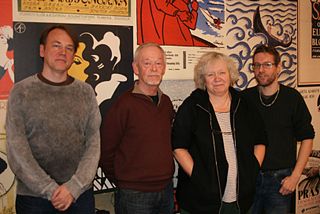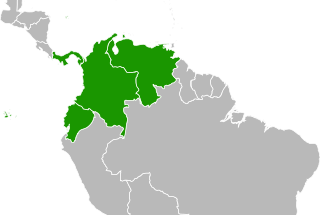
In computing, a database is an organized collection of data stored and accessed electronically. Small databases can be stored on a file system, while large databases are hosted on computer clusters or cloud storage. The design of databases spans formal techniques and practical considerations, including data modeling, efficient data representation and storage, query languages, security and privacy of sensitive data, and distributed computing issues, including supporting concurrent access and fault tolerance.
Structured Query Language, abbreviated as SQL,( "sequel", S-Q-L; ) is a domain-specific language used in programming and designed for managing data held in a relational database management system (RDBMS), or for stream processing in a relational data stream management system (RDSMS). It is particularly useful in handling structured data, i.e. data incorporating relations among entities and variables.

The Internet Broadway Database (IBDB) is an online database of Broadway theatre productions and their personnel. It was conceived and created by Karen Hauser in 1996 and is operated by the Research Department of The Broadway League, a trade association for the North American commercial theatre community.

Sequence homology is the biological homology between DNA, RNA, or protein sequences, defined in terms of shared ancestry in the evolutionary history of life. Two segments of DNA can have shared ancestry because of three phenomena: either a speciation event (orthologs), or a duplication event (paralogs), or else a horizontal gene transfer event (xenologs).

Structurae is an online database containing pictures and information about structural and civil engineering works, and their associated engineers, architects, and builders. Its entries are contributed by volunteers and saved in a MySQL database.
The DrugBank database is a comprehensive, freely accessible, online database containing information on drugs and drug targets created and maintained by the University of Alberta and The Metabolomics Innovation Centre located in Alberta, Canada. As both a bioinformatics and a cheminformatics resource, DrugBank combines detailed drug data with comprehensive drug target information. DrugBank has used content from Wikipedia; Wikipedia also often links to Drugbank, posing potential circular reporting issues.
Canmore is an online database of information on over 320,000 archaeological sites, monuments, and buildings in Scotland. It was begun by the Royal Commission on the Ancient and Historical Monuments of Scotland. Historic Environment Scotland has maintained it since 2015. The Canmore database is part of the National Record of the Historic Environment, formerly the National Monuments Record of Scotland and contains around 1.3 million catalogue entries. It includes marine monuments and designated official wreck sites, such as the wreck of HMS Pheasant (1916).
The facility ID number, also called a FIN or facility identifier, is a unique integer number of one to six digits, assigned by the U.S. Federal Communications Commission (FCC) Media Bureau to each broadcast station in the FCC Consolidated Database System (CDBS) and Licensing and Management System (LMS) databases, among others.
The Internet Off-Broadway Database (IOBDB), also formerly known as the Lortel Archives, is an online database that catalogues theatre productions shown off-Broadway.
The Centre de Données astronomiques de Strasbourg is a data centre which collects and distributes astronomical information . It was established in 1972 under the name Centre de Données Stellaires by the National Institute of Astronomy and Geophysics (INAG). The on-line services currently provided by the CDS include:

The Japanese Movie Database, more commonly known as simply JMDb, is an online database of information about Japanese movies, actors, and production crew personnel. It is similar to the Internet Movie Database but lists only those films initially released in Japan. Y. Nomura started the site in 1997, and it contains movies from 1899 to the present day.
The BC Geographical Names is a geographic name web service and database for the Canadian province of British Columbia run by the Base Mapping and Geomatic Services Branch of the Integrated Land Management Bureau. The database contains official names and spellings of towns, mountains, rivers, lakes, and other geographic places. The database often has other useful information, such as the history of geographic names, and their use in history.
Fauna Europaea is a database of the scientific names and distribution of all living multicellular European land and fresh-water animals. It serves as a standard taxonomic source for animal taxonomy within the Pan-European Species directories Infrastructure (PESI). As of June 2020, Fauna Europaea reported that their database contained 235,708 taxon names and 173,654 species names.
The Australian Heritage Database is a searchable online database of heritage sites in Australia. It is maintained by the Department of Agriculture, Water and the Environment as of 2022, in consultation with Australian Heritage Council. There are more than 20,000 entries in the database, which includes natural, historic and Indigenous heritage places, held in separately maintained lists.
The Base Mérimée is the database of French monumental and architectural heritage, created and maintained by the French Ministry of Culture. It was created in 1978, and placed online in 1995. The database is periodically updated, and contains more than 320,000 entries as of October 2020. It covers religious, domestic, agricultural, educational, military and industrial architecture, and is subdivided into three domains: historical monuments, general inventory, and architecture. The database was named after writer, historian and inspector-general of historical monuments Prosper Mérimée, who published the first survey of historic monuments in 1840.

The Swedish Film Database is an Internet database about Swedish films, published by the Swedish Film Institute. It contains information about all Swedish films from 1897 onwards and foreign films that had cinema premiere in Sweden. It also provides many biographies of actors, directors, producers etc. who participated in Swedish films over the years. It is created with the support of the Bank of Sweden Tercentenary Foundation. The database comprises about 62,000 films and 265,000 people.
The National Heritage List for England (NHLE) is England's official database of protected heritage assets. It includes details of all English listed buildings, scheduled monuments, register of historic parks and gardens, protected shipwrecks, and registered battlefields. It is maintained by Historic England, a government body, and brings together these different designations as a single resource even though they vary in the type of legal protection afforded to them. Although not designated by Historic England, World Heritage Sites also appear on the NHLE; conservation areas do not appear since they are designated by the relevant local planning authority.
HanCinema is an independent South Korean movie and drama database created by Cédric Collemine during the summer of 2003 in Korea. It provides information related to Korean movies, television dramas, actors, and other related information. It is aimed at non-South Korean audiences.
Tropicos is an online botanical database containing taxonomic information on plants, mainly from the Neotropical realm. It is maintained by the Missouri Botanical Garden and was established over 25 years ago. The database contains images and taxonomical and bibliographical data on more than 4.2 million herbarium specimens. In addition, it contains data on over 49,000 scientific publications. The database can be queried in English, French, and Spanish. The oldest records in the database go back to 1703.

Reunification of Gran Colombia refers to the potential future reunification of Colombia, Venezuela, Ecuador, and Panama under a single government. There have been attempts of reunification since 1903, when Panama separated from Colombia. People in favor for a reunification are called "unionistas" or unionists. In 2008, Hugo Chávez, president of Venezuela, announced the proposal of the political restoration of the Gran Colombia, under the Bolivarian revolution.






